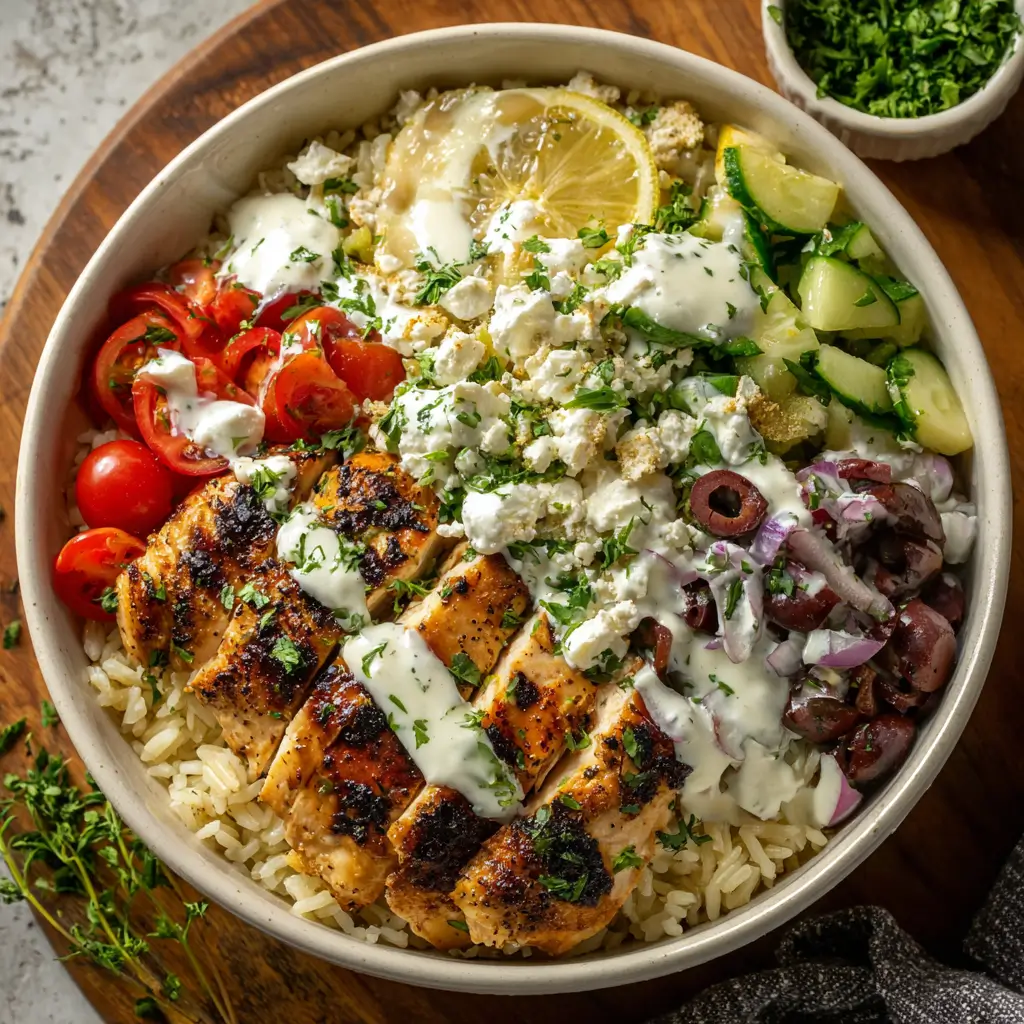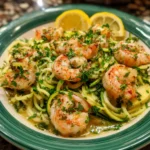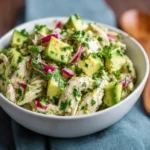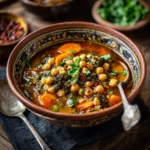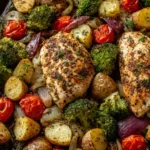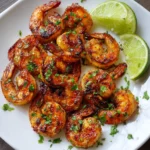Greek Chicken Bowls: A Flavorful Mediterranean Delight
Introduction
The Greek Chicken Bowl is a vibrant, wholesome meal that brings the sun-drenched flavors of the Mediterranean straight to your kitchen. Packed with lean protein, fresh vegetables, tangy feta cheese, and aromatic herbs, this dish offers a perfect balance of taste and nutrition. Whether you’re looking for a quick weeknight dinner, a nutritious lunch option, or a meal-prep favorite, the Greek Chicken Bowl delivers on every level. Its versatility allows for endless customization while maintaining its authentic essence, making it a beloved choice among health-conscious eaters and food lovers alike.
The History
The roots of the Greek Chicken Bowl can be traced back to traditional Greek cuisine, which emphasizes fresh ingredients, olive oil, herbs, grilled meats, and whole grains—hallmarks of the famed Mediterranean diet. While the concept of a “bowl” as a modern meal format gained popularity in the 21st century, particularly in American culinary trends, its foundation lies in ancient Greek eating habits. Greeks have long enjoyed meals composed of grilled meats, such as souvlaki or kontosouvli, served alongside pita bread, tzatziki, tomatoes, cucumbers, olives, and feta cheese.
In recent years, the bowl trend emerged as a healthier alternative to sandwiches and fast food, promoting balanced portions and colorful, nutrient-dense components. The Greek Chicken Bowl evolved naturally from these traditions, combining classic Greek flavors into a convenient, deconstructed format that celebrates seasonal produce and clean eating. Today, it’s a staple in meal delivery services, fitness diets, and home kitchens around the world, symbolizing both cultural heritage and modern wellness.
Ingredients Breakdown
Understanding each ingredient in a Greek Chicken Bowl helps appreciate not only the flavor profile but also the nutritional benefits they bring. Here’s an in-depth look at what goes into this delicious dish:
- Chicken Breast: A lean source of high-quality protein essential for muscle repair and satiety. It’s mild in flavor, making it ideal for absorbing marinades.
- Olive Oil: Extra virgin olive oil is central to Mediterranean cooking. Rich in heart-healthy monounsaturated fats and antioxidants, it enhances moisture and adds richness to the marinade.
- Lemon Juice: Freshly squeezed lemon juice provides acidity that tenderizes the chicken and brightens the entire dish with a zesty kick.
- Garlic: Adds depth and pungency; known for its immune-boosting properties and antimicrobial effects.
- Dried Oregano: A quintessential Greek herb with earthy, slightly floral notes that complement grilled meats beautifully.
- Paprika: Adds a subtle warmth and rich color without excessive heat, enhancing visual appeal.
- Salt and Black Pepper: Essential seasonings that enhance all other flavors in the dish.
- Cucumber: Provides crunch and hydration. High in water content and low in calories, it contributes freshness.
- Tomatoes: Juicy, sweet, and packed with lycopene—an antioxidant linked to reduced risk of heart disease and certain cancers.
- Red Onion: Offers sharpness and color. When soaked briefly in cold water, its bite mellows for better integration.
- Kalamata Olives: Briny, buttery olives native to Greece. They add healthy fats and a signature Mediterranean flair.
- Feta Cheese: Made traditionally from sheep’s or goat’s milk, feta delivers a creamy texture and tangy flavor. It’s lower in fat than many cheeses but higher in sodium.
- Quinoa or Brown Rice: Whole grains that serve as the base. Quinoa is a complete protein containing all nine essential amino acids, while brown rice offers fiber and sustained energy.
- Tzatziki Sauce: A cool, creamy yogurt-based sauce made with cucumber, garlic, lemon, and dill. It balances bold flavors and adds probiotics from fermented yogurt.
- Fresh Herbs (Parsley, Dill): Not just garnishes—they contribute phytonutrients, aroma, and vibrancy.
Step-by-Step Recipe
- Marinate the Chicken: In a large bowl, whisk together ¼ cup olive oil, juice of 1 lemon, 3 minced garlic cloves, 1 tablespoon dried oregano, 1 teaspoon paprika, 1 teaspoon salt, and ½ teaspoon black pepper. Add 1.5 lbs (about 680g) boneless, skinless chicken breasts, ensuring they are fully coated. Cover and refrigerate for at least 30 minutes—or ideally 2 to 4 hours—for maximum flavor infusion.
- Cook the Grain Base: Rinse 1 cup quinoa under cold water. In a medium saucepan, combine quinoa with 2 cups water or low-sodium chicken broth. Bring to a boil, then reduce heat to low, cover, and simmer for 15 minutes until liquid is absorbed and quinoa is fluffy. Remove from heat, fluff with a fork, and let sit covered for 5 minutes. Alternatively, prepare brown rice using a 1:2 ratio of rice to water, cooking for about 40–45 minutes.
- Grill or Pan-Sear the Chicken: Preheat grill or nonstick skillet over medium-high heat. Remove chicken from marinade (discard excess marinade). Cook chicken for 6–7 minutes per side, depending on thickness, until internal temperature reaches 165°F (74°C). Let rest for 5 minutes before slicing into thin strips.
- Prepare the Vegetables: Dice 1 large cucumber, 2 medium tomatoes, and ½ red onion. Toss them gently in a bowl. Optionally, soak the chopped onion in ice water for 10 minutes to mellow its sharpness, then drain.
- Make Tzatziki Sauce (Optional Homemade Version): Combine 1 cup plain Greek yogurt, ½ cup grated cucumber (squeezed dry), 1 minced garlic clove, 1 tablespoon lemon juice, 1 tablespoon chopped fresh dill, 1 tablespoon olive oil, and salt to taste. Chill for at least 15 minutes before serving.
- Assemble the Bowls: Start with a base of cooked quinoa or brown rice. Top with sliced grilled chicken, cucumber-tomato-onion mix, crumbled feta cheese, and Kalamata olives. Drizzle generously with tzatziki sauce and finish with a sprinkle of fresh parsley or dill.
- Serve Immediately: Enjoy warm or at room temperature. These bowls also hold up well when chilled, making them excellent for meal prep.
Tips
- Marinating Time Matters: For deeper flavor, marinate the chicken overnight. Even 30 minutes makes a noticeable difference compared to unmarinated chicken.
- Don’t Overcook the Chicken: Use a meat thermometer to ensure precision. Overcooked chicken becomes dry and tough.
- Let Chicken Rest: Allowing the meat to rest after cooking helps retain juices, resulting in more tender slices.
- Rinse Quinoa: Always rinse quinoa before cooking to remove saponins, which can impart a bitter taste.
- Customize Heat Level: Add a pinch of red pepper flakes to the marinade or tzatziki if you enjoy a spicy kick.
- Prep Ahead: Chop vegetables, cook grains, and make tzatziki up to 3 days in advance. Store components separately to maintain texture.
- Use Fresh Lemon Juice: Bottled lemon juice lacks brightness and may contain preservatives—freshly squeezed is always best.
- Toast the Grains (Optional): Lightly toast quinoa in a dry pan before boiling to enhance nuttiness.
- Drain Cucumber for Tzatziki: Squeeze out excess moisture from grated cucumber using a cheesecloth or clean towel to prevent watery sauce.
- Budget-Friendly Swap: If feta is expensive, use a smaller amount or blend with ricotta salata for similar texture and saltiness.
Variations and Customizations
The beauty of the Greek Chicken Bowl lies in its adaptability. Here are some creative twists and dietary adaptations:
- Vegan Version: Replace chicken with grilled tofu, chickpeas, or lentils. Use dairy-free feta and vegan tzatziki (made with plant-based yogurt).
- Low-Carb/Keto Option: Skip the grains and serve over a bed of romaine lettuce, spinach, or shredded cabbage for a Greek-inspired salad bowl.
- Gluten-Free Friendly: Naturally gluten-free as written—just confirm all packaged ingredients (like broth or spices) are certified GF.
- Spicy Twist: Add harissa paste to the marinade or include pickled jalapeños in the topping mix.
- Mediterranean Grain Swaps: Try farro, bulgur wheat, or freekeh instead of quinoa or rice for varied textures and nutty flavors.
- Seafood Alternative: Substitute grilled salmon or shrimp for chicken for a coastal Greek feel.
- Add Roasted Veggies: Include roasted red peppers, zucchini, eggplant, or cherry tomatoes for deeper flavor and added nutrients.
- Fruit Infusion: Add diced peaches, figs, or pomegranate seeds for a sweet contrast during summer months.
- Herb Variations: Experiment with mint, basil, or oregano flowers for unique aromatic profiles.
- Dairy-Free Dressing: Blend tahini with lemon juice, garlic, and water for a creamy, dairy-free alternative to tzatziki.
- Breakfast Bowl Style: Top with a poached or fried egg for a protein-packed morning version.
Health Considerations and Nutritional Value
A typical Greek Chicken Bowl is not only delicious but also nutritionally balanced. Here’s a breakdown of key health aspects:
- High-Quality Protein: Chicken breast and Greek yogurt provide complete proteins necessary for tissue repair, enzyme production, and immune function.
- Heart-Healthy Fats: Olive oil and olives supply monounsaturated fats, which help reduce LDL (“bad”) cholesterol levels and support cardiovascular health.
- Rich in Antioxidants: Tomatoes (lycopene), garlic (allicin), and herbs like oregano contain compounds that combat oxidative stress and inflammation.
- Digestive Benefits: Fiber from vegetables and whole grains supports gut health and regular digestion. Probiotics in yogurt further promote a healthy microbiome.
- Low Glycemic Index: When prepared with whole grains and minimal added sugars, this meal has a gradual impact on blood sugar levels, beneficial for diabetics and energy stability.
- Vitamins and Minerals: Abundant in vitamin C (from lemon and tomatoes), vitamin K (from leafy greens), calcium (from feta), potassium (from cucumber and tomato), and iron (from chicken and quinoa).
- Sodium Awareness: Feta cheese and olives are naturally high in sodium. To reduce salt content, opt for reduced-sodium feta, limit portion sizes, or increase fresh vegetable volume.
- Balanced Macronutrients: A standard bowl typically contains approximately 45% carbohydrates, 30% protein, and 25% fat—ideal for sustained energy and fullness.
- Weight Management Support: High protein and fiber content increase satiety, helping control appetite and reduce snacking between meals.
- Allergen Notes: Contains dairy (feta, yogurt) and potential gluten if served with contaminated grains. Always check labels for allergens when modifying recipes.
Approximate Nutritional Information (Per Serving, serves 4):
| Nutrient | Amount |
|---|---|
| Calories | 520 kcal |
| Protein | 38 g |
| Total Fat | 22 g |
| Saturated Fat | 6 g |
| Carbohydrates | 45 g |
| Dietary Fiber | 7 g |
| Sugars | 8 g |
| Sodium | 850 mg |
| Cholesterol | 95 mg |
Note: Values vary based on specific ingredients and portion sizes used.
Ingredients
- 1.5 lbs (680g) boneless, skinless chicken breasts
- ¼ cup extra virgin olive oil
- Juice of 1 large lemon (about 3 tablespoons)
- 3 cloves garlic, minced
- 1 tablespoon dried oregano
- 1 teaspoon paprika
- 1 teaspoon kosher salt
- ½ teaspoon freshly ground black pepper
- 1 cup quinoa or 1 cup brown rice (uncooked)
- 2 cups water or chicken broth
- 1 large cucumber, diced
- 2 medium tomatoes, diced
- ½ red onion, finely chopped
- ½ cup Kalamata olives, pitted and halved
- ¾ cup crumbled feta cheese
- 1 cup Greek yogurt (for tzatziki)
- ½ cucumber, grated and drained (for tzatziki)
- 1 tablespoon fresh dill, chopped (for tzatziki)
- 1 tablespoon lemon juice (for tzatziki)
- 1 clove garlic, minced (for tzatziki)
- Fresh parsley or dill, for garnish
Directions
- In a mixing bowl, whisk together olive oil, lemon juice, minced garlic, oregano, paprika, salt, and black pepper.
- Add chicken breasts to the marinade, turning to coat evenly. Cover and refrigerate for 30 minutes to 4 hours.
- While chicken marinates, rinse quinoa thoroughly. In a saucepan, bring 2 cups of water or broth to a boil. Stir in quinoa, reduce heat to low, cover, and simmer for 15 minutes. Remove from heat and let stand for 5 minutes, then fluff with a fork. (If using brown rice, follow package instructions.)
- Heat a grill or skillet over medium-high heat. Remove chicken from marinade and cook for 6–7 minutes per side, until juices run clear and internal temperature reaches 165°F. Transfer to a cutting board and rest for 5 minutes before slicing.
- For tzatziki: Combine Greek yogurt, grated cucumber, dill, lemon juice, garlic, and a pinch of salt. Mix well and chill until ready to serve.
- In a large bowl, toss diced cucumber, tomatoes, and red onion. Set aside.
- To assemble each bowl: Place ¾ cup cooked quinoa or rice in a bowl. Arrange sliced chicken, vegetable mix, olives, and feta cheese on top. Drizzle with tzatziki and garnish with fresh herbs.
- Serve immediately, or store components separately in airtight containers for up to 4 days.
FAQ
- Can I use chicken thighs instead of breasts?
- Yes! Boneless, skinless chicken thighs work well and offer a juicier texture due to higher fat content. Adjust cooking time as needed—thighs may take slightly longer to reach safe internal temperature.
- How long do Greek Chicken Bowls last in the fridge?
- When stored properly in airtight containers, components stay fresh for 3–4 days. Assemble just before eating to maintain optimal texture.
- Can I freeze this meal?
- It’s best not to freeze assembled bowls. However, marinated raw chicken and cooked grains can be frozen separately for up to 3 months. Thaw in the refrigerator before use.
- Is tzatziki available store-bought?
- Yes, many grocery stores carry tzatziki in the refrigerated section near cheeses or dips. Look for varieties with simple ingredients—no artificial preservatives.
- What can I substitute for feta cheese?
- Ricotta salata, halloumi (grilled), or even a small amount of goat cheese can mimic feta’s salty, tangy character.
- Can I make this recipe ahead of time?
- Absolutely! This dish is perfect for meal prep. Cook the chicken and grains, chop veggies, and make tzatziki in advance. Store separately and assemble when ready to eat.
- Are Greek Chicken Bowls suitable for kids?
- Yes, especially if you adjust seasoning to be less salty or spicy. Kids often enjoy the creamy tzatziki and colorful toppings.
- Can I grill the vegetables too?
- Definitely! Grilled zucchini, bell peppers, or eggplant add smoky depth and pair wonderfully with the chicken.
- Is this dish gluten-free?
- Yes, provided all ingredients (especially broth and spices) are certified gluten-free. Avoid cross-contamination if serving with pita bread.
- How can I bulk up the bowl for more calories?
- Add avocado slices, extra olives, hummus, or a boiled egg to increase healthy fats and caloric density—ideal for athletes or those needing more energy.
Summary
The Greek Chicken Bowl is a harmonious fusion of Mediterranean tradition and modern healthy eating, offering bold flavors, vibrant colors, and balanced nutrition. Easy to customize, satisfying to eat, and perfect for any occasion—from weekday lunches to elegant meal prep—it’s no wonder this dish has become a global favorite.
